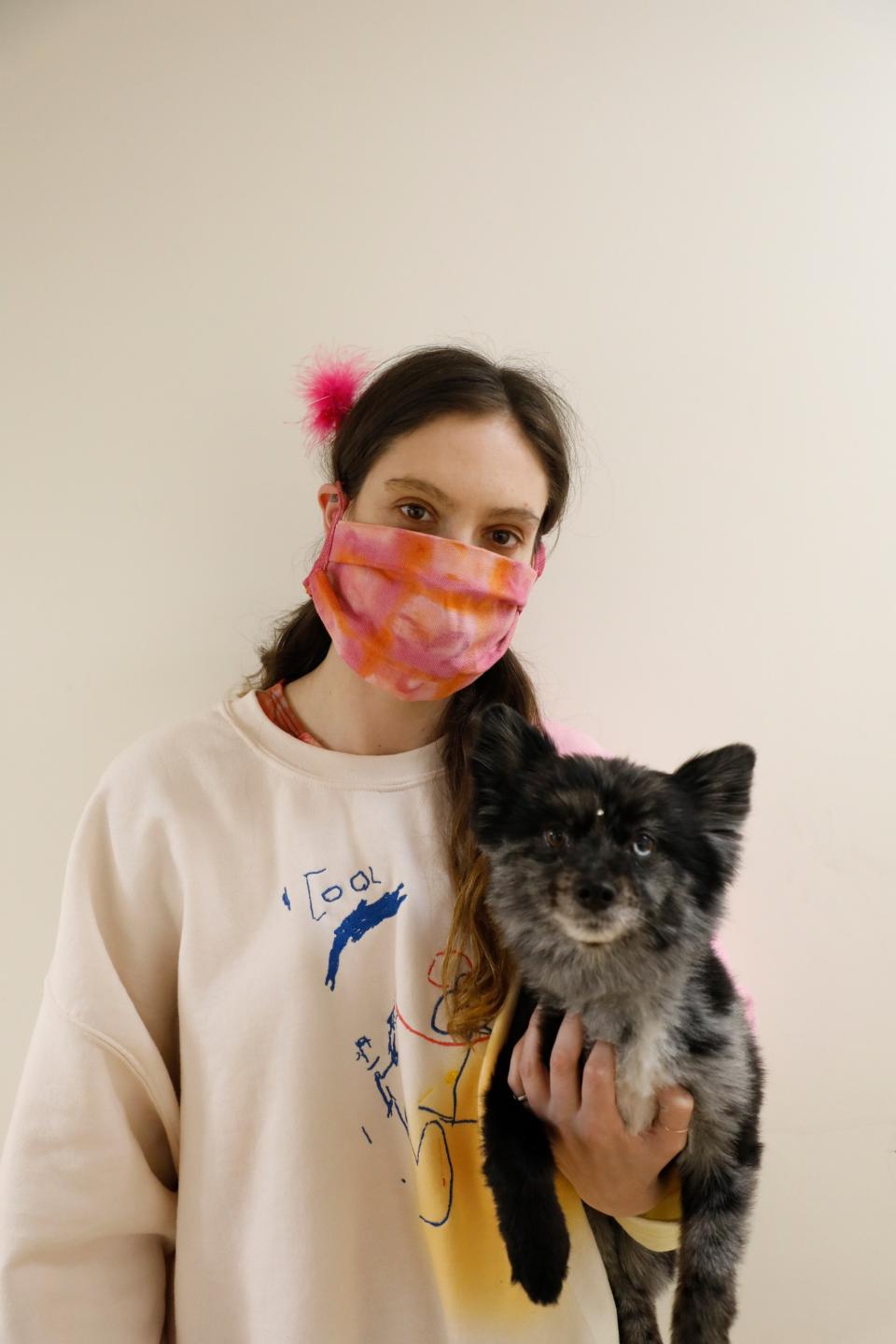Collina Strada’s Hillary Taymour Shows How to Sew and Tie Dye A Cloth Mask

Three days ago, the CDC officially set forth recommendations that everyone, regardless of whether they’re showing symptoms or not, should wear cloth face coverings in public settings. While there’s been debate over the past few weeks over the efficacy of certain types of face masks, a simple cloth mask is now recommended for non-healthcare workers -- leave the surgical masks and N-95 respirators for medical professionals. The CDC also published tutorials that can help you sew a mask out of tightly woven cotton fabric or household items like a T-shirt or a bandana.
Designer Hillary Taymour of Collina Strada has been ahead of the curve and sewing cloth masks from deadstock fabrics in her Chinatown studio for the past three weeks. “I started making them right before New York went into lockdown. I was just like, you know what, I’m going to start making these because people are going to need them.” Her assistant, interns, and staff have been chipping in from their own homes, sewing and sending all of their cloth masks directly to Masks4Medicine, the social media campaign started by Dr. Nicole Seminara, a doctor at NYU Langone Health, that solicits homemade masks from the public. Those crowdsourced masks are then donated to healthcare providers, clinics, and nursing homes.
Alone in her studio, Taymour’s been using the deadstock fabric and leftover dye in her studio to make colorful cloth masks that she’s added to every e-commerce order that she receives.“We’re trying to have a one-to-five ratio,” she says, meaning for every one mask that goes to a website order, five go to Masks4Medicine. She just found a supplier that’s going to ship her white cloth masks en masse, which she’ll then tie dye and sell on the website starting later today or tomorrow. “So if you buy one of those, you’ll donate five masks to ERs.”
She can tell that people have been placing orders just to get these masks—she says that people have been buying the cheapest items on the website, from all around the world, asking for her to include as many masks as possible in the shipment. “I’m getting people reaching out to me from Prague saying they’re getting fined leaving the house without a mask on. When a family reaches out to me and says, ‘I’m going to buy a sweatshirt, can you please send more masks for my small children,’ I of course want to help as many people as I can, but I’m still one person.” She’s running low on supplies herself—she’s low on cotton at the moment, so if any designers have an abundance of cotton sitting unused in their studio, Taymour requests that they send it her way so she can make more masks.
In her DMs alone, the demand has been staggering. But she can only make around 40 masks a day by hand. “You wouldn't believe my inbox right now. I go home and start crying because I can’t make all of these,” she says. “By doing this and actually seeing the demand, it’s so much bigger than one city and so much bigger than one person. It can’t just be my thing to make a mask anymore. We all need to start doing it.”
Below, Taymour’s shared a guide to sewing these masks in the hopes that people will not only make them for themselves, but that they will donate as many as they can to Masks4Medicine. For at home tie dyes, she suggests using turmeric, artichokes, and beets, which are the easiest to get the color out of (this will get you pale yellow, green, and deep red dyes, respectively) but you could also use onion skins, coffee grounds, or avocado skins.
If you just want to sew a mask, here’s how:
Step 1: Cut 2 rectangles of cloth 6” x 9” and two smaller 1.5” x 36”.
Step 2: Sew the rectangles together on the 9” side only.
Step 3: Iron the strips to hide the seams.
Step 4: Turn the rectangle inside out and pleat with an iron.
Step 5: Sew the strips along the pleated 6” side. And you’re all set—You made a mask!
How to tie dye at home:
Step 1: Chop whatever raw organic materials (artichoke, avocado skins, or turmeric) you’re using and bring to a boil in a pot of water. Let simmer for an hour, and then strain it and set aside.
Step 2: Prepare the fabric to soak up the dye by rinsing it under cold water. If you’re using plant matter, you need to add one part vinegar to four parts water and bring the fabric to a boil in this mixture.
Step 3: Add the fabric to the dye that you made in Step 1. Simmer until it’s reached the color that you want (if you want it to really soak up the dye, leave it overnight).


Taymour cutting her cotton fabric.

Taymour measuring out the fabric.

Taymour measuring out the strips.


Taymour getting all of the fabric in place.


Taymour ironing the pleats.


Taymour turning the rectangle inside out to pleat.




Pleating the mask.

More pleating.




Taymour sewing the strips.


Taymour's leftover natural dyes.



Taymour in her tie-dyed mask.
Originally Appeared on Vogue

